Exposure
Choosing a Shooting Mode
To choose a shooting mode, hold the mode dial lock release and rotate the mode dial. The shooting mode is shown in the shooting display.
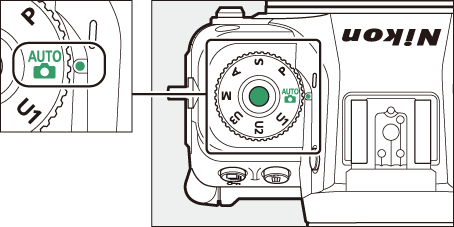
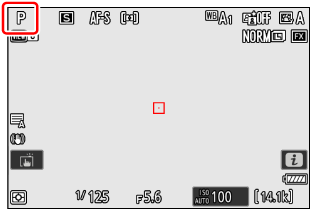
| Mode | Description | |
|---|---|---|
| AUTO (b) | Auto (0 Taking Photographs (b Mode), Recording Videos (b Mode)) | A simple “point-and-shoot” mode that leaves the camera in charge of settings. In addition to the shutter speed and aperture, the camera also automatically controls white balance and other items. |
| P | Programmed auto (0 P (Programmed Auto)) | Use for snapshots and in other situations in which there is little time to adjust camera settings. The camera chooses both shutter speed and aperture automatically. |
| S | Shutter-priority auto (0 S (Shutter-Priority Auto)) | Use to freeze or blur motion. You choose the shutter speed; the camera adjusts aperture automatically. |
| A | Aperture-priority auto (0 A (Aperture-Priority Auto)) | Use to blur backgrounds or bring both foreground and background into focus. You choose the aperture; the camera adjusts shutter speed automatically. |
| M | Manual (0 M (Manual)) | You control both shutter speed and aperture. Choose a shutter speed of “Bulb” or “Time” for long time-exposures. |
| U1 U2 U3 |
User setting mode (0 U1, U2, and U3 (User Setting Mode)) | Assign frequently-used settings to these positions. The settings can be recalled simply by rotating the mode dial. |
b (Auto)
In addition to the shutter speed and aperture, the camera also automatically controls white balance and other items. Of the functions that can be configured by the menu, those controlled by the camera automatically are grayed out and unavailable. To change the settings of grayed-out menu functions, change the shooting mode to P, S, A, or M.
P (Programmed Auto )
In this mode, the camera automatically adjusts shutter speed and aperture according to a built-in program to ensure optimal exposure in most situations.
- You can set ISO sensitivity, white balance, and other items that would be controlled automatically in b (auto).
Different combinations of shutter speed and aperture that produce the same exposure can be selected by rotating the main command dial (“flexible program”) in mode P.
- While flexible program is in effect, a flexible program indicator (U) is displayed.
- To restore default shutter speed and aperture settings, rotate the main command dial until the indicator is no longer displayed. Flexible program can also be ended by choosing another shooting mode or turning the camera off.
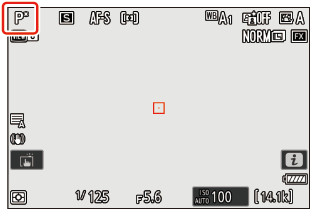
S (Shutter-Priority Auto )
In shutter-priority auto, you choose the
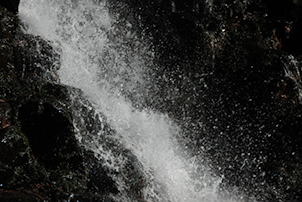
Fast shutter speed (¹/₁₆₀₀ s)
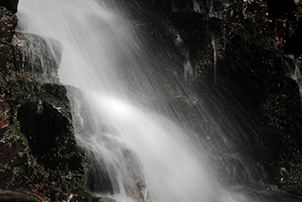
Slow shutter speed (1 s)
- Rotate the main command dial to set the shutter speed.
- Shutter speed can be set to values between ¹⁄₈₀₀₀ s and 30 s.
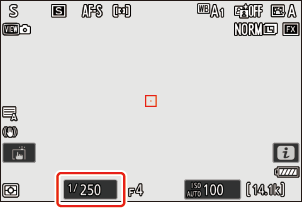
- When [Electronic front-curtain shutter] is selected for Custom Setting d6 [Shutter type], shutter speed is limited to ¹⁄₂₀₀₀ s, even when it is set faster.
- When [Electronic shutter] is selected for Custom Setting d6 [Shutter type], shutter speeds as fast as ¹/₁₆₀₀₀ s can be selected.
- Shutter speed can be locked at the selected value (0 f5: Control Lock, g3: Control Lock).
A (Aperture-Priority Auto )
In aperture-priority auto, you choose the
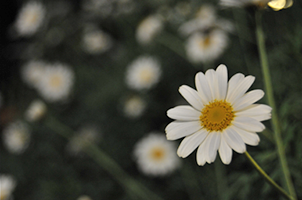
Large aperture (f/5.6)
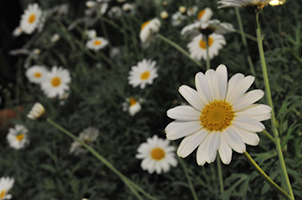
Small aperture (f/22)
- Aperture can be adjusted by rotating the sub-command dial.
- The minimum and maximum values for aperture vary with the lens.
- Aperture can be locked at the selected value (0 f5: Control Lock, g3: Control Lock).
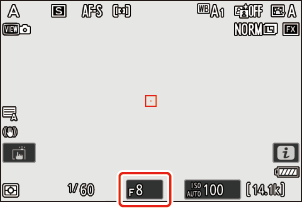
M (Manual )
You control both
- Shutter speed and aperture can be adjusted with reference to the exposure indicators by rotating the command dials.
- Rotate the main command dial to choose the shutter speed. Shutter speed can be set to values between ¹⁄₈₀₀₀ s and 30 s or to
Bulb orTime .
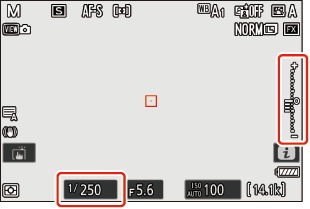
- When [Electronic front-curtain shutter] is selected for Custom Setting d6 [Shutter type], shutter speed is limited to ¹⁄₂₀₀₀ s, even when it is set faster.
- When [Electronic shutter] is selected for Custom Setting d6 [Shutter type], shutter speeds as fast as ¹/₁₆₀₀₀ s can be selected.
- Aperture can be adjusted by rotating the sub-command dial.
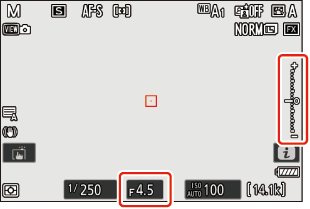
- The minimum and maximum values for aperture vary with the lens.
- Shutter speed and aperture can be locked at the selected values (0 f5: Control Lock, g3: Control Lock).
U1, U2, and U3 (User Setting Mode )
Frequently-used settings can be assigned to user setting positions U1 through U3 and later recalled simply by rotating the mode dial.
Saving User Settings
Adjust settings.
The settings that can be saved include:
- photo shooting menu options,
- video recording menu options,
- Custom Settings, and
- Shooting mode, shutter speed (modes S and M), aperture (modes A and M), flexible program (mode P), exposure compensation, etc.
Highlight [Save user settings] in the setup menu and press 2.
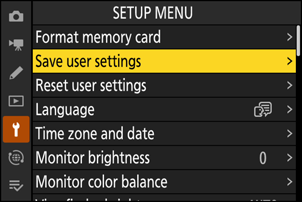
Select the user settings position to assign settings.
Select [Save to U1], [Save to U2], or [Save to U3], and then press 2.
Save user settings.
Highlight [Save settings], and press J to assign current settings to the selected position.
Take pictures using the saved settings.
You can rotate the mode dial to U1, U2, or U3 to enable shooting with the settings assigned to that position.
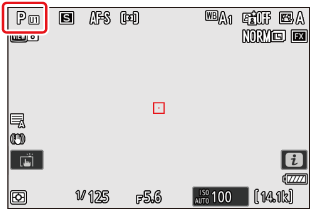
Items That Cannot Be Assigned to U1, U2, and U3
The following cannot be saved to U1, U2, or U3.
PHOTO SHOOTING MENU
- [Storage folder]
- [Manage Picture Control]
- [Multiple exposure]
- [Interval timer shooting]
- [Time-lapse video]
- [Focus shift shooting]
- [Pixel shift shooting]
VIDEO RECORDING MENU
- [Storage folder]
- [Manage Picture Control]
Resetting User Settings
Highlight [Reset user settings] in the setup menu and press 2.
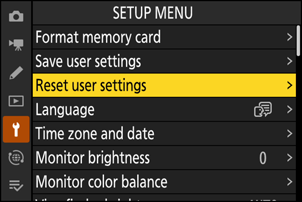
Select a user settings position to reset.
Select [Reset U1], [Reset U2], or [Reset U3], and then press 2.
Reset user settings.
Highlight [Reset] and press the J button to restore default settings for the selected position (the camera will function in mode P).
The exposure indicators in the monitor and viewfinder show whether the photograph would be under- or over-exposed at current settings. The exposure indicators can be read as follows (the display varies with the option selected for Custom Setting b2 [EV steps for exposure cntrl]):
| Display | [1/3 EV (comp. 1/3 EV)] selected for [EV steps for exposure cntrl] | ||
|---|---|---|---|
| Optimal exposure | Underexposed by 1/3 EV | Overexposed by over 3 1/3 EV | |
| Monitor |  |
 |
 |
| Viewfinder |  |
 |
 |
The orientation of the exposure indicators can be reversed using Custom Setting f8 [Reverse indicators].
The displays will flash if the selected settings exceed the limits of the exposure metering system.
For shutter speeds as slow as 900 s (15 minutes) in mode M, select [ON] for Custom Setting d7 [Extended shutter speeds (M)].
At speeds slower than 1 s, the shutter speed displayed by the camera may differ from the actual exposure time. The actual exposure times at shutter speeds of 15 and 30 seconds, for example, are respectively 16 and 32 seconds. The exposure time will again match the selected shutter speed at speeds of 60 seconds and slower.
Auto ISO Sensitivity Control (Mode M)
If auto ISO sensitivity control (0 Auto ISO Sensitivity Control) is enabled, ISO sensitivity will automatically be adjusted for optimal exposure at the selected shutter speed and aperture.
Long Time-Exposures (Mode M Only)
The camera offers two options for long time-exposures: “
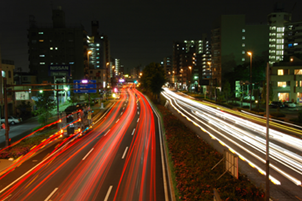
A 35-second exposure shot at a shutter speed of “Bulb” and an aperture of f/25
| Shutter speed | Description |
|---|---|
| Bulb | The shutter remains open while the shutter-release button is held down. |
| Time | The exposure starts when the shutter-release button is pressed and ends when the button is pressed a second time. |
Keep the camera steady, for example by using a tripod.
While pressing the mode dial lock release, rotate the mode dial to M.
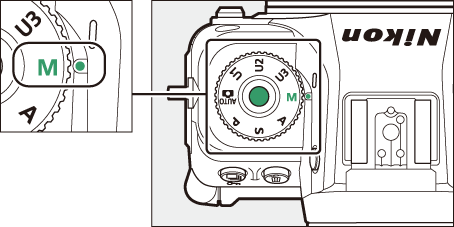
Rotate the main command dial to choose a shutter speed of Bulb (“Bulb”) or Time (“Time”).
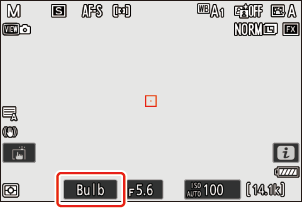
Bulb
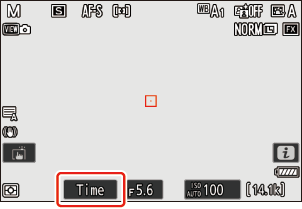
Time
Note that the exposure indicators are not displayed at a shutter speed of Bulb or Time.
Focus and start the exposure.
- “Bulb”: Press the shutter-release button all the way down to start the exposure. Keep the shutter-release button pressed during the exposure.
- “Time”: Press the shutter-release button all the way down to start the exposure.
The elapsed time is shown in the control panel.
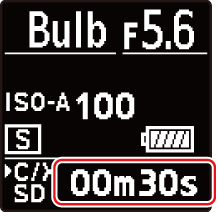
End the exposure.
- “Bulb”: Lift your finger from the shutter-release button.
- “Time”: Press the shutter-release button all the way down a second time.
- Note that “noise” (bright spots, randomly-spaced bright pixels or fog) may be present in long exposures.
- Bright spots and fog can be reduced by choosing [ON] for [Long exposure NR] in the photo shooting menu.
We recommend using one of the following power sources to prevent loss of power during long exposures:
- A fully-charged battery
- An optional EH-8P AC adapter connected using the supplied USB cable (featuring Type-C connectors at both ends)
- An optional EP‑5B power connector with an EH‑5d, EH‑5c, or EH‑5b AC adapter
- A third-party portable charger
- To prevent blur, use of a tripod or a device such as an optional remote cord or wireless remote controller is recommended.
- Note that optional ML‑L7 remote controls function in “Time” mode even when a shutter speed of Bulb is selected.
Autoexposure (AE) Lock
Use autoexposure lock to lock exposure, preventing the camera adjusting exposure automatically.
- To set the autoexposure lock, press the center of the
sub-selector . - Keeping the center of the sub-selector pressed locks exposure, preventing it changing in response to changes in composition or subject brightness.
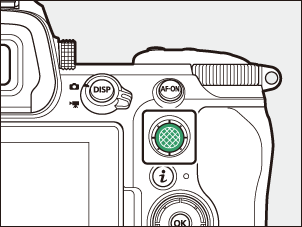
- An AE-L icon will appear in the shooting display.
- If autofocus is enabled, press the shutter-release button halfway to focus before pressing the center of the sub-selector. This locks both focus and exposure.
- While keeping the center of the sub-selector pressed, recompose the photograph and shoot.
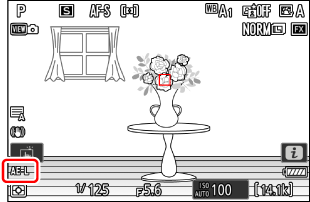
Locking Exposure with the Shutter-Release Button
If [On (half press)] is selected for Custom Setting c1 [Shutter-release button AE-L], exposure will lock while the shutter-release button is pressed halfway.
- With [Spot metering], exposure will be locked at the value metered in a circle centered on the current focus point.
- With [Center-weighted metering], exposure will be locked at a value weighted toward a 12-mm circle in the center of the display.
Adjusting Shutter Speed and Aperture
The following settings can be adjusted while the center of the sub-selector is pressed:
| Shooting mode | Setting |
|---|---|
| P | Shutter speed and aperture (flexible program; 0 P (Programmed Auto)) |
| S | Shutter speed |
| A | Aperture |
- The new values can be confirmed in the shooting display and control panel.
Exposure Compensation
Exposure compensation is used to alter exposure from the value suggested by the camera. It can be used to make pictures brighter or darker.
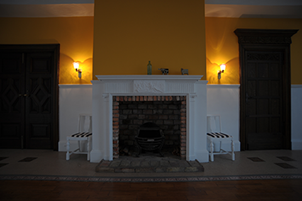
−1 EV
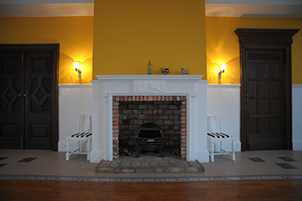
No exposure compensation
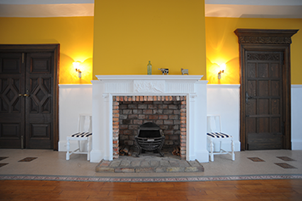
+1 EV
Adjusting Exposure Compensation
Hold the
- Choose from values between –5 EV (underexposure) and +5 EV (overexposure). Values between –3 EV and +3 EV are available in video mode.
- At default settings, changes to exposure compensation are made in increments of ¹⁄₃ EV. The size of the increments can be changed using Custom Setting b2 [EV steps for exposure cntrl].
- Higher values make the subject brighter, lower values darker.

- The set exposure compensation value is displayed in the control panel.
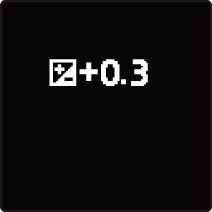
The shooting display shows the E icon and indicators in photo mode and the E icon in video mode. The current exposure compensation value can be confirmed by pressing the E button.

Monitor
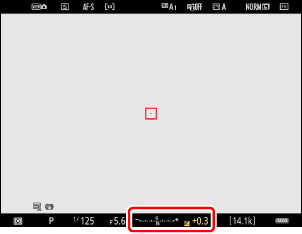
Viewfinder
- Normal exposure can be restored by setting exposure compensation to ±0.0. Exposure compensation is not reset when the camera is turned off.
- In mode M, exposure compensation affects only the exposure indicator; shutter speed, aperture, and ISO sensitivity do not change. Actual exposure does not change.
- Press the E button to confirm the compensation amount by value and indicator.
- When auto ISO sensitivity control (0 Auto ISO Sensitivity Control) is in effect, ISO sensitivity is automatically adjusted according to the value selected for exposure compensation, changing overall exposure.
When an optional flash is used, exposure compensation affects both flash level and exposure, altering the brightness of both the main subject and the background; if desired, the effect can be restricted to the background using Custom Setting e3 [Exposure comp. for flash].
